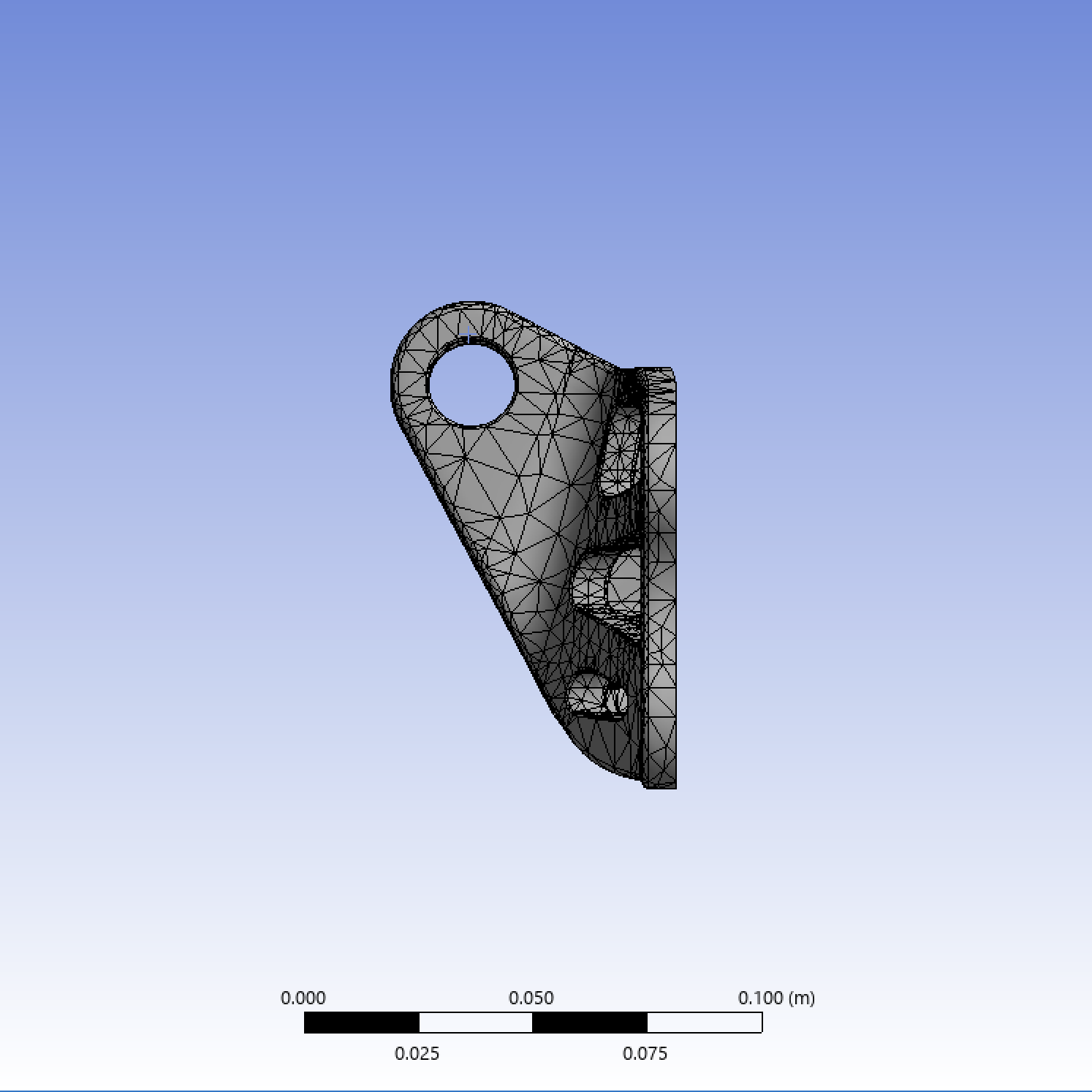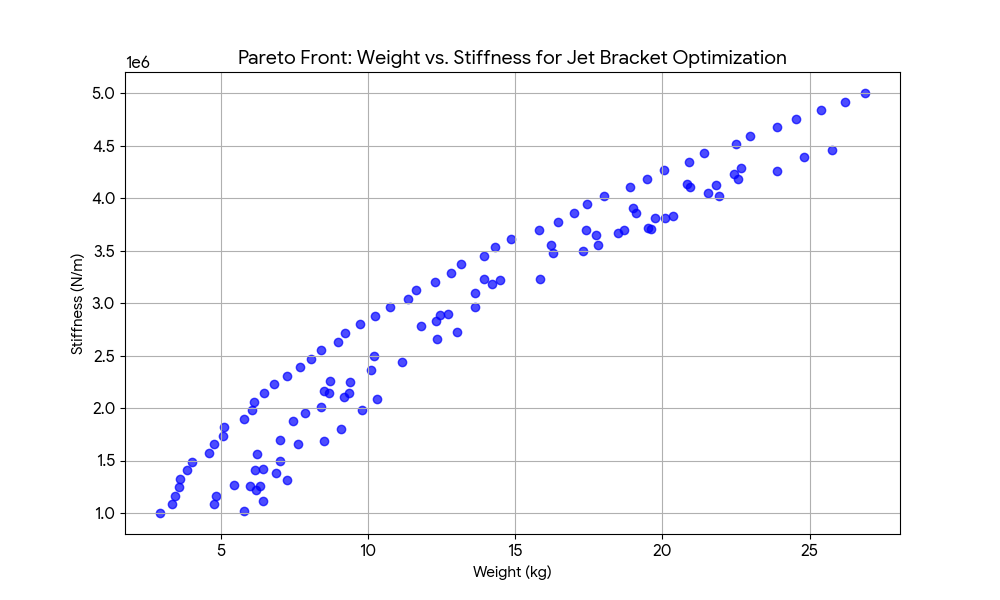The design of high-performance components, particularly in demanding fields like aerospace, is fundamentally constrained by the limitations of traditional Finite Element Analysis (FEA). This conventional process is a major bottleneck, characterized by time-consuming, manual iterations in model setup (preprocessing), simulation (processing), and results interpretation (postprocessing). The result is extended design cycles and a risk of settling for suboptimal outcomes due to intense time pressures.
To address these fundamental challenges, we propose a Multi-Agent System for FEA. This paradigm introduces a suite of specialized AI agents that collaborate with the engineer in a "copilot" model. Each agent is designed to automate and intelligently optimize a specific stage of the workflow—from geometry preparation and adaptive meshing to automated error correction and advanced, generative optimization.
By leveraging this agent-based approach, we transform a linear, laborious process into a dynamic and highly efficient one. As demonstrated with the optimization of a lightweight jet bracket, this system not only drastically reduces design cycle time from days to hours but also delivers quantifiably superior outcomes. The AI-driven optimization agents explore vast design spaces to uncover novel, high-performance geometries that are often non-intuitive to human engineers, leading to significant improvements in weight, durability, and overall performance.
Ultimately, this framework represents a paradigm shift, empowering engineers to move beyond tedious manual tasks and focus on strategic oversight and creative problem-solving. It promises not just accelerated innovation and cost savings, but a distinct competitive advantage in the development of next-generation products.
.png)
Our simulation case is of an aerospace jet bracket, where we are looking to both understand how the design will perform, as well what the Pareto front of optimized designs may look like. We have the following simulation conditions:
Component: A 3D CAD model of an existing jet engine bracket
Material: Aerospace-grade aluminum alloy
Loads: Static and dynamic loads representing operational forces, including thrust, vibration, and thermal expansion.
Constraints: Fixed bolt-hole locations for mounting, specific displacement limits, and stress concentration thresholds.
Design Goal: Reduce the bracket's weight while maintaining or improving structural integrity and meeting all safety factors.
Topology Optimization: Identifying the optimal material distribution within a defined design space to meet performance targets.
Parametric Optimization: Fine-tuning geometric parameters (e.g., fillet radii, rib thicknesses) for improved performance.
Performance Validation: Ensuring the optimized design meets all specified load conditions and safety margins. Also, checking how do the tolerances for the part’s geometric parameters affect the performance of the part. This could also affect Design For Manufacturing, if there is a process in place.
Reduced Design Cycle Time: Significantly cut down the time spent on FEA iterations.
Enhanced Design Quality: Achieve a lighter bracket with superior structural performance.
Cost Savings: Reduced computational resources and engineering time.
Novel Insights: Uncover design possibilities that might be overlooked by traditional manual methods.
With these key goals in mind, let’s discuss how to use targeted AI agents across the Finite Element Analysis workflow, discussing each agent in depth.
Our AI-accelerated FEA workflow leverages specialized agents at each stage, working collaboratively with the engineer (using a copilot) to achieve unparalleled efficiency, confidence in outcomes, and design quality.
.png)
This phase, before a simulation is run, typically involves CAD cleanup, material property assignment, load and boundary condition definition, and meshing. It's often the most time-consuming and error-prone part of traditional FEA.
Generally, in simulation, geometry cleanup and preparation is a massive pain point, taking hours to do tedious manual cleanup - even with software claiming to "automate" most of the process. With a context-driven agent, this can become a truly AI-driven process that has full understand of the design on the level an engineer does.
This agent automatically identifies and cleans up geometric imperfections (e.g., small faces, sliver edges) in the CAD model. It also suggests optimal simplification for FEA without compromising critical features. The agent can use rule-based algorithms and machine learning models trained on vast datasets of CAD geometries to detect and correct common issues.
Meshing is another incredibly difficult, tedious endeavor. Even though some software can generate high-quality tetrahedral meshes, high-quality hex meshing remains elusive, and convergence studies can be tedious and long-running to perform. By applying agents to this process, you can both get a better base state of your mesh with refinements in the right areas, and automate the process of convergence studies.
This agent intelligently applies, thinks about, and corrects mesh parameters based on the desired analysis type, load conditions, and critical regions (e.g., stress concentration areas). It automatically refines mesh density in high-gradient regions and coarsens it elsewhere, and even can perform a convergence study given the right parameters to iterate over. The AI employs adaptive meshing algorithms guided by real-time feedback from the user and simulation. It can also learn from previous successful meshing strategies for similar components, minimizing human intervention.


Later in preprocessing boundary conditions (BCs) are applied. Agents here can be used in a few ways, including zero-shot verification and validation of applied BCs, as well as natural language implementation of complicated specifications.
This agent interprets engineering specifications and automatically applies appropriate loads, constraints, and interactions. It can read the parameters of the simulation and detect common errors like unconstrained rigid body motions, before the simulation is even run. This agent utilizes natural language processing to understand textual descriptions of conditions and maps them to FEA software commands.
Throughout this process, the engineer is always in control - the engineer defines initial meshing goals (e.g., target element size, areas of interest). The agent proposes a mesh, and the engineer can override specific parameters or highlight areas for further refinement. The agent then implements the changes and validates the mesh quality. This ensures the human and AI agents can make high quality decisions together at every step.
Once the model is prepared, the processing phase involves running the FEA solver. This process can be computationally intensive, and unexpected errors can cause significant delays.
Manages the solver execution, monitors progress, and handles resource allocation. Interfaces directly with the FEA solver (e.g., Abaqus, ANSYS) to do so.

When a user (or the human-agent copilot) identifies a bug or an unexpected simulation halt, this agent diagnoses the problem. It suggests potential fixes, such as adjusting solver parameters, refining mesh, or re-evaluating boundary conditions. Leverages a knowledge base of common FEA errors and their solutions, augmented by machine learning models that can identify anomalous behavior in solver logs. It can even autonomously rerun simulations with adjusted parameters until a stable run is achieved.
The engineer is notified of any issues. The agent provides a diagnosis and suggested solutions, which the engineer can approve or modify. The agent then executes the corrections. This dramatically reduces troubleshooting time.
This phase is where the raw simulation data is transformed into actionable insights, leading to design improvements, and where agents can be leveraged the most in the simulation process.
Result generation, interpretation, and analysis in simulation traditionally requires generating code and interpreting graphs, tables, and other engineering information from a simulation. These tasks in particular are things AI Agents excel at. We propose a multi-agent system for results targeting each of these sub-problems.
Automatically extracts key performance indicators (KPIs) from the simulation results, such as maximum stress, displacement, and deformation. It identifies critical regions and potential failure points. Applies predefined analysis criteria and can even learn from previous successful design validations to prioritize specific metrics. This agent may even be able to work with the engineer to uncover new insights about simulations that an engineer may miss.

This is where true advanced decision-making and generative capabilities shines. It takes the analysis results and, based on the defined optimization goals (e.g., 20% weight reduction), iteratively proposes design modifications. It can perform:
Topology Optimization: Generate optimal material distribution within the design space.
Parametric Optimization: Adjust geometric features (e.g., hole sizes, rib thicknesses, fillet radii) to meet performance criteria.
We propose a Design of Experiments for the agent with the relevant factors/levels, let the user approve the DoE, and then the agent works on getting each to run. Once we collect the data, we can analyze them all together. There are so many ways to construct DoEs, an agent can tool call across contexts to build them.
Multi-Objective Optimization: Simultaneously optimize for multiple conflicting objectives (e.g., minimize weight while maximizing stiffness).
The agent can employ advanced algorithms like genetic algorithms or even trained surrogate models, should they be available. It can autonomously run multiple design iterations, learn from each simulation's outcome, and converge on the optimal design much faster than traditional methods. Crucially, it can explore design spaces that a human engineer might not consider, leading to novel, high-performing geometries.

The integration of AI agents across the FEA workflow provides compelling advantages:
Manual meshing, model cleanup, and convergence studies could take days; agents reduce this to hours, if not minutes.
Automated error detection and adaptive meshing lead to more robust and accurate initial models, reducing downstream issues.
Automated error debugging and intelligent solver management significantly reduce simulation run times and prevent wasted computational cycles from failed runs.
More reliable simulation runs with fewer manual interventions.
Automated analysis and report generation eliminate tedious manual data extraction and report writing, saving days of work. It also allows users to build trust in the simulation having users work with AI to verify and check key components. Optimization iterations, which would take weeks manually, are completed in hours.
The AI Optimization Agent discovers novel, highly efficient designs that human engineers might not conceive alone. This leads to significantly lighter, stronger, and more durable components. The comprehensive reports generated by agents are of higher quality and provide deeper, data-driven insights.
Absolutely. The Optimization Agent can identify non-intuitive load paths, discover highly efficient material distributions, and propose complex geometries that are mathematically optimal but difficult for a human to conceptualize manually, all without engineering invention. For instance, it might run an experiment over a day or two, and, given the results, suggest a lattice structure within a solid part to achieve significant weight savings while maintaining strength, without having a human intervene.
The human-agent copilot approach allows the engineer to focus on high-level design decisions and creative problem-solving, rather than getting bogged down in repetitive, rule-based tasks. The agents handle the computational heavy lifting and iterative refinement, acting as intelligent assistants that augment human capabilities. By using AI agents across the Finite Element Analysis process, we were able to generate a series of optimized designs and validate performance with a trusted simulations in a fraction of the time traditional methods would take.
By embedding AI agents throughout the FEA process, from intelligent preprocessing to AI-driven optimization and automated report generation, we can achieve a paradigm shift in engineering design. For the lightweight jet bracket, this translates to not just optimized weight/stress tradeoffs and improved fatigue life, but also a drastic reduction in design cycle time, enabling faster innovation and higher-performing products, with fewer mistakes.
If these kind of problems resonate with you and your team, we are in beta! Contact us here, or at rui@cosmon.com for more information.